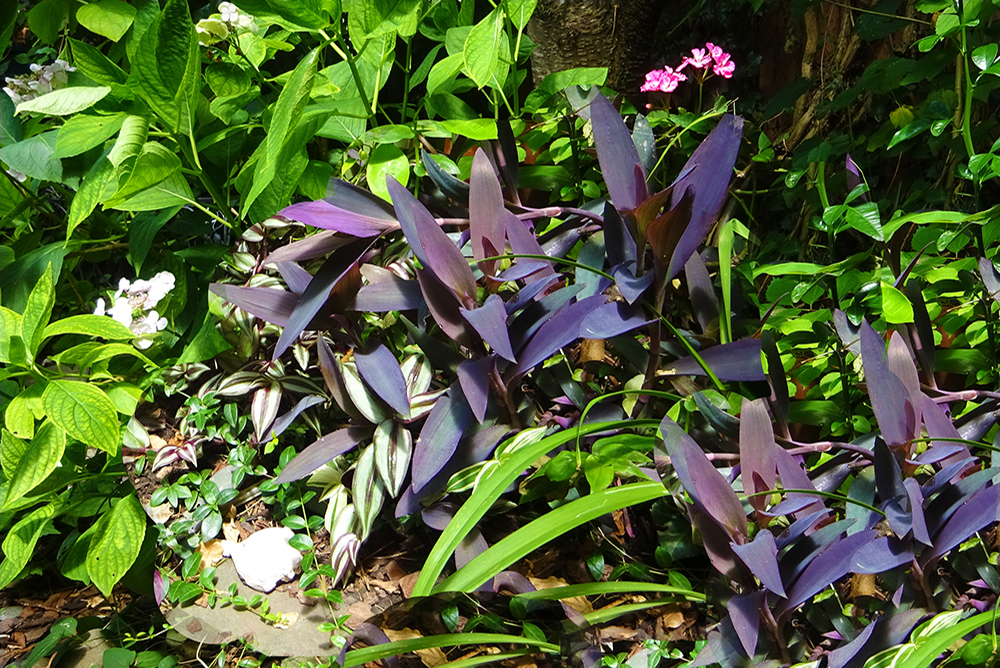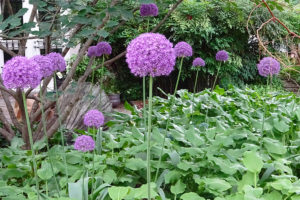
Tradescantia pallid. / Above and cover photo by Stephanie Cavanaugh.
I JUST FLIPPED through 42 Googlets on the care, feeding and propagation of spiderwort—or, as my Jewish grandmother called it, wandering jew. This is the plant least likely to require any instructions whatsoever.
I have been growing tradescantia pallida (as it’s more haughtily called) since 1972, or thereabouts, when Stan and Betty Gottlieb gave me a sprig snipped on a trip to Jamaica or Trinidad or Aruba. I stuck it in one of the many potted avocado plants that lined the windowsill of the New York apartment I shared with my husband once removed (the Pre-Prince), and it grew.
Avocado plants raised from pits (stick a couple of toothpicks into the sides and balance on a glass of water until roots emerge) do not usually fruit, at least in northern climes. They are useful as screens, however, in this case softening an unglamorous view of Columbus Avenue (except when Robert Redford, in all his Butch Cassidy glory, was playing tennis across the street). They are also fine starter plants for budding gardeners since the process is so stupidly simple.
Similarly, you really have to work hard to come up with instructions for cultivating spiderwort—which is why it’s amazing that so many people have done so (me included, now it seems).
Pinch a bit off and stick it in soil.
They grow in the sun, they grow in the shade, they grow in crappy soil, they can survive an illegal trip home from the Dominican Republic wrapped in a wet bathing suit (got me a variegated variety that way). But they don’t care if it’s dry either.
Being tropical, they do not survive frost, but a couple of sprigs wintered over in the kitchen window—a glass of water will do, though they won’t protest a little dirt—will grow long and leggy and can be snipped and snipped again and plopped in pots and borders and baskets in spring.
And sometime around now, when bare spots inevitably appear in the garden or window boxes, you’ll have such an abundance of these leggy sprigs that gaps can be filled instantly and thus: Break off a piece, stick forefinger in soil, insert snipping, tamp soil down. If you feel like watering, do so. If not, it’ll rain soon enough, probably.
The avocados and the spiderwort, along with my myriad and ultimately ghastly collection of spider (aka chlorophytum) plants, were of a propagation technique called Entirely Accidental, with a result so stunning to the perpetrator (me) that it was, to get Olympian about it, like sticking a Yurchenko vault with 2½ twists (yes, I looked up “most difficult gymnastics vault”).
Purely as an aside here, the Washington Post says macramé plant hangers, the blight of the 1960s Bohemian look, are back in style. Time to start cultivating the spider plants again, I suppose. Sigh.
Returning to the subject, it has taken years, nay decades, for me to realize that one can purposely and quite easily propagate other plants, a whole host of them! (I rarely deploy exclamation points, but this one is so deserved.)
I assumed, when I gave it any thought at all, that anything beyond putting a plant on a windowsill or in a yard and then praying that it would at least live was best left to the experts, someone schooled in the alchemy of grafting and light and fertilization… A British accent helps, or a name like Agatha or Clive. But it was none of the business of mortals.
Occasionally Agatha or Clive issue mumbled convoluted and entirely inconvenient, messy and possibly dangerous instructions (involving knives) for doing this or that, while no doubt snickering behind a hand.
For instance, one or the other of them wrote that you can just yank geraniums out before frost and hang them by their roots in the basement or garage (or a closet if you’ve neither) to winter over. So for some years I did that, suspending their withering foliage and dirty feet from wire hangers hung on a basement beam. Many survived but when repotted looked hellish, bent and scrawny and slow to flower, and I’d trudge off to buy new ones.
And then—how did this happen? I realized that all one has to do is snip a twig of a branch, dip the cut end in some rooting substance (just ask for rooting substance at the garden center) and—as with those wandering jews—stick your finger in a pot, pop in the stem end, water and “Done.” I haven’t bought a geranium in years. If they get leggy-looking, break off a leg and stick it somewhere. Set the pot in a little patch of sun and they will grow. Easy enough?
However, it took me until now to discover there are all manner of plants this can be done with! (I have to exclaim again here.) And, you don’t necessarily need any special equipment or fancy potting medium—except maybe a pencil or a chopstick if you don’t want to dirty your finger.
The geraniums and wandering jew have a fat juicy stem in common. If you come across something of similar stem, do the dip and poke and see what happens. This can be done at any time of the year.
Plants with woody stems take marginally more effort—and apparently, this is the ideal time to do so. Don’t fall asleep here.
Late spring or early summer—now—is a ripe time for propagation. I found this out after looking for a website on cuttings and coming across this Aussie, who (by the way) called clippers secateurs, which is how I happened to mention them myself last week.
And I came across the Aussie because I was wandering the street with a stolen stem of I-don’t-know-what but it was pretty, and was halted in my tracks by an actual employed gardener who said, “Where did you get that? Throw it away, it’s poisonous, and don’t touch any orifice”—yes, he said that, and all sorts of visions ensued—”until you’ve thoroughly washed your hands.”
So as soon as I got home I immediately stuck it in a corner of a window box to see what it will do, and went off to wash. I am fine.
As I was chatting with the employed gardener, who kept imploring me to ditch my stem and Stop wiping the perspiration off my cheeks with my fingers (it was hot out), I asked about propagating and he said, grumpily, “Google ‘cuttings cutting cuttings.’ ” He said that three times, so that’s just what I did.
And the Aussie, who was the cutest of the lot that popped up, and of course had that accent that proclaimed authority, explained that you want the growth to be new, but firm; not sweet and fragile little buddlings that waver limply, but not so hard that you can’t cut them with the kitchen scissors when you’re not using them to snip chives or cut packing tape or some such. After that, it’s just dip and poke again.
I brought the question to my favorite Facebook group, Container Gardening Gone to Pot, which I joined many months ago because I was enchanted by the name. Sometimes the postings are less than useful, a photo of someone holding a rose asking, What is this flower? And all the photos of “fairy gardens,” a concept I detest.
But lurking are fine resources. In this case, after asking the group for suggestions, one reader directed me to Plant Propagation by Alan Toogood ($25.36), published by the American Horticultural Society. Toogood is, among other things, Horticulture Correspondent for the London Times (wouldn’t you just know).

Alliums, elsewhere on the Cavanaugh plantation. / Photo by Stephanie Cavanaugh.
What a delightful encyclopedia of propagation it is; 318 helpfully illustrated pages covering everything from garden trees to roses, fuchsias to bougainvillea, some of it, like grafting, too exhausting to contemplate, but so much of it entirely accessible and as easy as dip and poke.
A complete primer on what to snip from a friend’s—or employ my favorite garden-center trick, the oops-this-bit-fell-off—and equally valuable, understanding when not to bother. Camellias, for instance, root easily from cuttings but can take three to four years to flower.
Right. Have I told you about the Raleigh Farmer’s Market? If you have about four hours and a car, you can get a beautifully budded camellia, cheap, and fried Twinkies too.
—Stephanie Cavanaugh
Gardener Cavanaugh is working on a book about city gardening and will join us again next week for her latest legal and extra-legal tips.

We did this with our penny mac hydrangeas. plants r cool like that 😉
Budded camellia and FRIED ? twinkies must I go to Raleigh??
Will try cuttings galore but will they work in Florida??